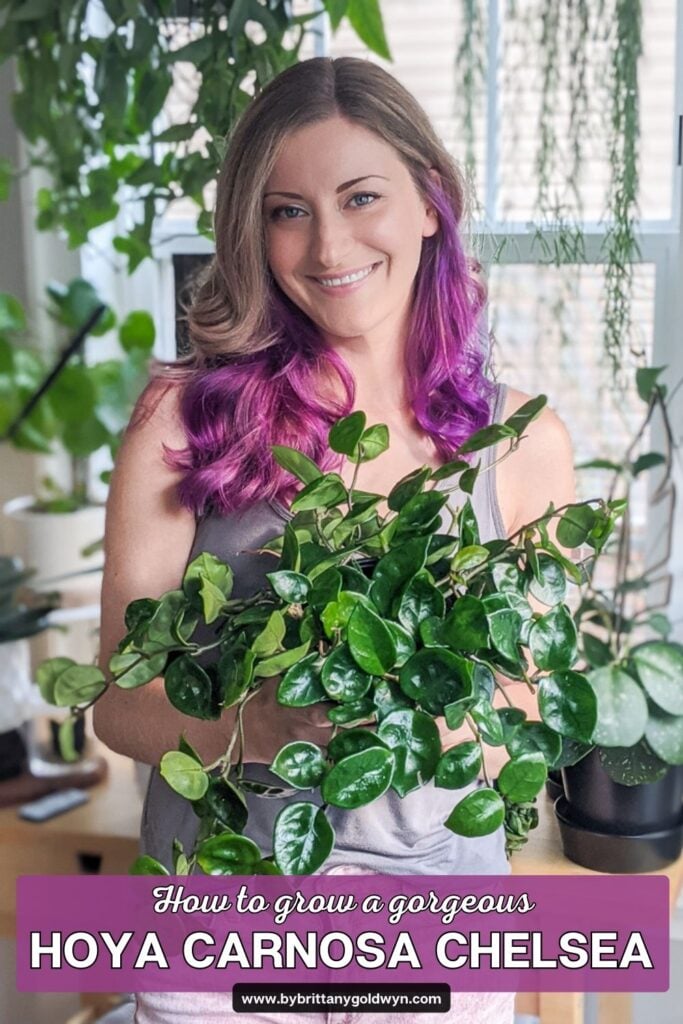All about growing the Hoya Chelsea!
Today we’re talking about another Hoya. The “Hoya Carnosa Chelsea,” a variety of Carnosa that goes by many names: Honey plant, Chelsea Wax plant, Porcelain Flower, Wax vine, and more.
Hoyas have been cultivated for over 200 years, which has prompted the creation of many different variants. The Hoya Chelsea is now found naturally growing in the wilds of Queensland, China, East India, and Southeast Asia. And maybe your living room? 🙂

Identifying Chelsea
So what does Chelsea look like? It is distinguished from other similar Hoyas by its puckered, glossy leaves. The leaves on the Chelsea do not unfurl at full size, either. Leaves sprout from the stems and remain small and lighter in color for a while, eventually growing to their full size and color.
Hoya Chelsea plants can grow quite long—up to 12 feet, in fact. Though you likely won’t achieve that as a potted plant indoors. They can grow to decent length in a hanging basket, or you can train them to vine up a trellis. I have mine in a hanging basket, and it’s lovely.


Light
Chelsea thrives in bright, indirect light. Too much direct sunlight will burn the leaves. However, Hoya Chelsea can withstand some direct morning sun since it is not as harsh as afternoon sun.
Outdoors, make sure it is in a bright but shaded area. Our backyard gets a lot of light from late morning well into early evening, and I have had mine hanging under my covered patio with great success. It is shaded all day but receives dappled light through the upper deck slats.
If Chelsea isn’t getting enough light, it will start to drop leaves. The leaves will also be farther apart on the stems and likely smaller. (This is called “leggy”—it’s actually “reaching” for the light.)

Water
Hoyas in general are very drought tolerant. You should wait until at least the top few inches of soil have dried out before you water the plant again. I often let the soil dry out completely with no issues.
I water my Hoyas roughly once a week in the spring and summer, much less in the fall and winter. Outdoors the temperature is much higher, so although it is super humid, the soil dries out faster.
I usually try to let mother nature do her thing with my outdoor plants, but I’ll give my hanging baskets an extra drink during dry spells. I usually just feel the basket for its weight or stick my finger in the top of the soil.
The worst thing you can do for this plant is water it too much. Overwatering Chelsea will lead to root rot. If your plant leaves are developing dark spots, are wilting, and are getting mushy, you might want to check the roots.
Your plant is suffering from root rot if the roots are getting gray and mushy. Snip the affected roots off of your plant (and the gross leaves) and then repot the plant in fresh soil. Wait a few days to water and then resume care as normal.

Soil
Most high-quality well-draining houseplant soil mixtures will do just fine for Hoya Carnosa Chelsea. I usually throw in an extra handful of perlite to further enhance drainage. You can also use orchid bark, but I find that makes some soils too well-draining.
Succulent soil mixes can also work for Hoyas. See my recipe for how to mix succulent soil at home. So if that’s all you have on hand, it will work! Whatever you choose, keep “well-draining” in mind.

Temperature & humidity
Hoya Chelsea does well in all normal household temperatures. However, it does best in warmer temperatures. Shoot for over 70 degrees Fahrenheit. If it gets too hot, you may need to water it more.
Like other Hoyas, it will struggle under 50–60 degrees Fahrenheit, though it can survive a few cold snaps. It is not frost-hardy and will die in temperatures below freezing.
Chelsea also does best in a variety of normal humidity levels, but it will really thrive in higher humidity. My Chelsea was plugging along happily indoors, but once I took it out on my patio for the humid Maryland summer, it exploded with growth!
Indoors, you can add a humidifier or consider something like a higher humidity greenhouse cabinet. Check out my Ikea greenhouse cabinet for more ideas.

Repotting & pruning
Hoyas in general are pretty slow growers, but they can grow quite well under the right circumstances. Mine is growing like nuts outside on my covered patio—it loves that summer humidity!
Therefore, Hoya Carnosa Chelseas don’t need to be repotted often. Every few years should be fine. I don’t plan to repot mine until I see roots start to peek out of the drainage holes. That means it’s crying for more room.
Simply repot your Chelsea with fresh well-draining soil and give it a thorough watering. At this point, you can also prune any excess foliage. I have trimmed mine a few times to encourage fullness. And as a bonus, you can propagate the cuttings!

Propagation
I love propagating plants, and Chelsea is an easy one to propagate. You should propagate your Chelsea in the spring or summer since it is actively growing and will take root faster.
The easiest way to do it is through a stem cuttings. First, take a cutting that’s a few inches long. Make sure it has a few leaves and an exposed node. The best way to do this is by finding a stem that has already lost a leaf. However, if you don’t have one of those, you can simply take the cutting and remove the bottom two leaves to expose the stem.
You can then put the cutting in a growing medium. I like to skip water rooting for hoyas and root them directly in a well-draining medium.
In soil, keep the soil moist for a few weeks until you feel resistance when you tug the cutting. In moss, put the cutting in a mixture of damp sphagnum moss and perlite. Keep a plastic baggie over the top so the moss retains moisture and let the humidity do its thing.
You can take the baggie off to check the rooting process, but usually you can see it through the container if you use a clear plastic container. Another option is to use a DIY plant propagation box.

Flowering
Hoya Carnosa Chelsea also generates inflorescences—or clusters of flowers—from “spurs” or “peduncles” on the stems. Peduncles will form first and over time, buds will appear from the tips. Each flower typically takes 2–3 weeks to fully mature.
Chelsea’s flowers are unique and immediately recognizable, much like other Hoya flowers. They are grouped in star-like clusters. Not only is the arrangement in the shape of a star, but each flower also has the appearance of a five-pointed wax star. For more on flowering and hoyas, see my article on How to Get a Hoya to Bloom.

Wrapping up…
Hoya Chelsea remains one of my absolute favorite Hoyas. I love how wild it looks once the stems really start getting long and unruly, and the puckered leaves give it a distinctive look. Questions about caring for this plant? Drop them below, and happy planting!
Pin my guide!


Brittany is a seasoned DIY home and garden expert, running a creative brand since 2014 that inspires others with approachable plant care guides, woodworking tutorials, and decor projects. She is a certified project manager and has completed extensive coursework in the art and science of growing your own plants. Her work has been recognized by major publications, and she routinely collaborates with fellow DIY industry leaders—but her favorite thing to do is inspire you! Learn more about her here.

Leave a comment